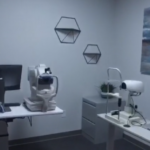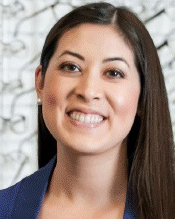
Special testing room in Dr. Woo’s practice. The doctor says the experience of starting her own practice was rich with valuable lessons.
By Stephanie Woo, OD, FAAO, FSLS
Dec. 30, 2020
Starting a practice cold is not for the faint of heart. It comes with challenges, from equipping the office, to recruiting the right support staff team, marketing the new practice, and beyond. Here are several lessons I learned from the experience of opening my practice cold, some of which I wish I known to begin with.
Prepare for Unexpected Costs
When preparing your business plan for the bank, add an additional 20 percent extra on top of the amount you are requesting. This will help cover additional fees that you were not aware of or expecting. I ended up needing this money to build out my office space. There was additional money that I owed due to cabinetry redesign, electrical work and window work. Not having that extra money on hand forced me to go about 20 percent above my budget. The key takeaway here is to be prepared for the unexpected.
Create Marketing Plan Prior to Opening
My practice does not accept any patient insurance. I should have started planning much earlier how I would address that in my marketing. Most optometry clinics accept insurance, so when patients call to schedule an appointment, that is often one of the first things my staff and I discuss with them. We have to educate patients on why our clinic is different, so they see the value in what we are doing. If a patient truly wants a different experience, they will schedule an appointment. However, because the patient volume is low in a practice that doesn’t accept insurance, we have to work hard at gaining patients.
In retrospect, I should have started working on marketing materials before the clinic opened. I started designing promotional materials right after the clinic opened. If I had designed them ahead of time, and had then printed them prior to opening, that would have given me a head start in recruiting new patients.
I’m continuing to develop relationships with referring doctors to show them how we are different, and how we are providing their patients with an incredibly high level of care. Because I don’t take insurance, I am able to spend a tremendous amount of time with patients. That is something that some patients are looking for, and I want doctors and patients to think of us when they want this premium type of service.
It is humbling when you open a clinic that doesn’t accept insurance because patients are not going to be beating down your door for an appointment. You have to prove yourself with compassion, excellent service and provide exceptional results.
Build Staff Commensurate with Patient Volume
I didn’t have the funds to hire anyone at first, so I was doing everything for the first four months. I answered the phones, scheduled patients, uncovered the equipment, sanitized between each patient, worked up the patient, explained the fees and collected the money, on top of all of my doctor responsibilities.
If you only have one patient per day, there is no point in hiring another person when you clearly have time. Many doctors are uncomfortable performing support staff duties, but when you own your own business, every penny counts. Because payroll is usually the biggest, or second biggest, expense of most optometry clinics, I was able to save thousands of dollars this year by waiting several months before hiring.
It’s educational to be forced to do every single thing in your clinic, including things you’ve never done before. Even as an intern in optometry school, you don’t have to answer the phone and schedule patients. When you have to do everything within your office from start to finish, you gain great perspective on how you want the clinic to operate. It gives you a big picture of how you want the practice to grow.

The reception area in Dr. Woo’s new practice. She says it’s important to anticipate surprise costs, such as the unexpected expenses that arise when doing office build-outs.
When You Have Enough Patients to Afford it, Hire & Delegate Tasks
As the clinic grew, and I started to see more patients, I got busier and became more stressed out. There comes a tipping point when you need to hire someone to serve patients and help take stress off of yourself. Once I hired someone to help me, it was a huge relief, and I could focus my attention on doctoring.
I am glad that I did everything myself in the beginning, and I would not have changed anything about that experience. However, I probably waited too long to hire someone – I was working from 8 a.m. to 8 p.m. on most days, and even weekends, which was not good for my mental or physical health.
Now that I have a staff member to help me, I delegate tasks to her, so that I can focus on serving patients as doctor. For instance, instead of paying all the bills myself, I review them for accuracy, but then have my staff member pay them and record the receipts. Another way I delegate is that I will work on the content that I want to go into a newsletter, but I will have my staff member design it, print it, stamp it and mail it. Delegate anything you can, so you can maximize your efforts as doctor and practice leader, serving patients and focusing on the long-term plan.
Analyze your financials and figure out how that employee you would like to hire could pay for themselves. If an employee costs $100 per day, find a way to generate that extra income. Maybe you need to see two more exams per day or sell one more pair of glasses. If you set a measurable goal, it is easy to see if you are achieving it.
Having a staff member to assist me, now that I am much busier, has been a huge help to both my business and personal life.
 Stephanie Woo, OD, FAAO, FSLS, practices with the Contact Lens Institute of Nevada.
Stephanie Woo, OD, FAAO, FSLS, practices with the Contact Lens Institute of Nevada.

























